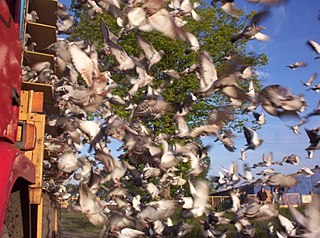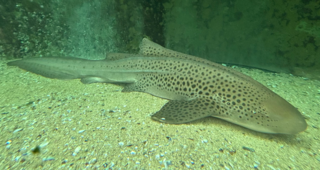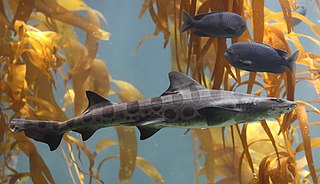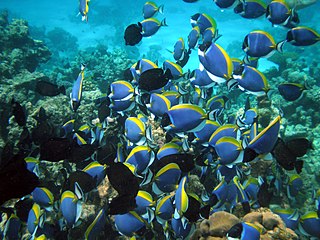Related Research Articles

The great white shark, also known as the white shark, white pointer, or simply great white, is a species of large mackerel shark which can be found in the coastal surface waters of all the major oceans. It is the only known surviving species of its genus Carcharodon. The great white shark is notable for its size, with the largest preserved female specimen measuring 5.83 m (19.1 ft) in length and around 2,000 kg (4,400 lb) in weight at maturity. However, most are smaller; males measure 3.4 to 4.0 m, and females measure 4.6 to 4.9 m on average. According to a 2014 study, the lifespan of great white sharks is estimated to be as long as 70 years or more, well above previous estimates, making it one of the longest lived cartilaginous fishes currently known. According to the same study, male great white sharks take 26 years to reach sexual maturity, while the females take 33 years to be ready to produce offspring. Great white sharks can swim at speeds of 25 km/h (16 mph) for short bursts and to depths of 1,200 m (3,900 ft).

Pigeon racing is the sport of releasing specially trained homing pigeons, which then return to their homes over a carefully measured distance. The time it takes the animal to cover the specified distance is measured and the bird's rate of travel is calculated and compared with all of the other pigeons in the race to determine which animal returned at the highest speed.

The northern elephant seal is one of two species of elephant seal. It is a member of the family Phocidae. Elephant seals derive their name from their great size and from the male's large proboscis, which is used in making extraordinarily loud roaring noises, especially during the mating competition. Sexual dimorphism in size is great. Correspondingly, the mating system is highly polygynous; a successful male is able to impregnate up to 50 females in one season.

Carpet sharks are sharks classified in the order Orectolobiformes. Sometimes the common name "carpet shark" is used interchangeably with "wobbegong", which is the common name of sharks in the family Orectolobidae. Carpet sharks have five gill slits, two spineless dorsal fins, and a small mouth that does not extend past the eyes. Many species have barbels.

The zebra shark is a species of carpet shark and the sole member of the family Stegostomatidae. It is found throughout the tropical Indo-Pacific, frequenting coral reefs and sandy flats to a depth of 62 m (203 ft). Adult zebra sharks are distinctive in appearance, with five longitudinal ridges on a cylindrical body, a low caudal fin comprising nearly half the total length, and usually a pattern of dark spots on a pale background. Young zebra sharks under 50–90 cm (20–35 in) long have a completely different pattern, consisting of light vertical stripes on a brown background, and lack the ridges. This species attains a length of 2.5 m (8.2 ft).

The lemon shark is a species of shark from the family Carcharhinidae, known for its yellowish color, which inspires its common name. It is classified as a Vulnerable species by the International Union for the Conservation of Nature. Lemon sharks can grow to 3.4 metres (11 ft) in length. They are often found in shallow subtropical waters and are known to inhabit and return to specific nursery sites for breeding. Often feeding at night, these sharks use electroreceptors to find their main source of prey, fish. Lemon sharks enjoy the many benefits of group living such as enhanced communication, courtship, predatory behavior, and protection. This species of shark gives birth to live young, and the females are polyandrous and have a biennial reproductive cycle. Lemon sharks are not thought to be a large threat to humans; there have been 10 recorded bites, none of which were life-threatening. The lemon shark's life span is unknown, but the average shark is 25 to 30 years old. The oldest recorded lemon shark in captivity died in 2023 at the age of 40 years.

The sand tiger shark, grey/gray nurse shark, spotted ragged-tooth shark or blue-nurse sand tiger, is a species of shark that inhabits subtropical and temperate waters worldwide. It inhabits the continental shelf, from sandy shorelines and submerged reefs to a depth of around 191 m (627 ft). They dwell in the waters of Japan, Australia, South Africa, and the east coasts of North and South America. The sand tiger shark also inhabited the Mediterranean, however it was last seen there in 2003 and is presumed extinct in the region. Despite its common names, it is not closely related to either the tiger shark or the nurse shark.

A mixed-species feeding flock, also termed a mixed-species foraging flock, mixed hunting party or informally bird wave, is a flock of usually insectivorous birds of different species that join each other and move together while foraging. These are different from feeding aggregations, which are congregations of several species of bird at areas of high food availability.

The leopard shark is a species of houndshark, in the family Triakidae. It is found along the Pacific coast of North America, from the U.S. state of Oregon to Mazatlán in Mexico. Typically measuring 1.2–1.5 m (3.9–4.9 ft) long, this slender-bodied shark is immediately identifiable by the striking pattern of black saddle-like markings and large spots over its back, from which it derives its common name. Large schools of leopard sharks are a common sight in bays and estuaries, swimming over sandy or muddy flats or rock-strewn areas near kelp beds and reefs. They are most common near the coast, in water less than 4 m (13 ft) deep.
Mackenzie Rosman is an American actress. She is known for her television role as Ruthie Camden on The WB's long-running drama series 7th Heaven.

The nurse shark is an elasmobranch fish in the family Ginglymostomatidae. The conservation status of the nurse shark is globally assessed as Vulnerable in the IUCN List of Threatened Species. They are considered to be a species of least concern in the United States and in The Bahamas, but considered to be near threatened in the western Atlantic Ocean because of their vulnerable status in South America and reported threats throughout many areas of Central America and the Caribbean. They are directly targeted in some fisheries and considered by-catch in others.

The cloudy catshark is a common species of catshark, belonging to the family Scyliorhinidae. It is a bottom-dweller that inhabits rocky reefs in the northwestern Pacific Ocean, from the shore to a depth of 320 m (1,050 ft). Growing up to 50 cm (20 in) long, this small, slim shark has a narrow head with a short blunt snout, no grooves between the nostrils and mouth, and furrows on the lower but not the upper jaw. It is also characterized by extremely rough skin and coloration consisting of a series of dark brown saddles along its back and tail, along with various darker and lighter spots in larger individuals.

The southern stingray is a whiptail stingray found in tropical and subtropical waters of the Western Atlantic Ocean from New Jersey to southern Brazil. It has a flat, diamond-shaped disc, with a mud brown, olive, and grey dorsal surface and white underbelly. The barb on its tail is serrated and covered in a venomous mucus, used for self-defense.
Spatial organization can be observed when components of an abiotic or biological group are arranged non-randomly in space. Abiotic patterns, such as the ripple formations in sand dunes or the oscillating wave patterns of the Belousov–Zhabotinsky reaction emerge after thousands of particles interact millions of times. On the other hand, individuals in biological groups may be arranged non-randomly due to selfish behavior, dominance interactions, or cooperative behavior. W. D. Hamilton (1971) proposed that in a non-related "herd" of animals, the spatial organization is likely a result of the selfish interests of individuals trying to acquire food or avoid predation. On the other hand, spatial arrangements have also been observed among highly related members of eusocial groups, suggesting that the arrangement of individuals may provide advantages for the group.

In biology, any group of fish that stay together for social reasons are shoaling, and if the group is swimming in the same direction in a coordinated manner, they are schooling. In common usage, the terms are sometimes used rather loosely. About one quarter of fish species shoal all their lives, and about one half shoal for part of their lives.

David William Sims is a British marine biologist known for using satellite tracking to study wild behaviour of sharks and for the Global Shark Movement Project. He is Senior Research Fellow at the Laboratory of the Marine Biological Association (MBA) in Plymouth, and a Professor of Marine Ecology in the National Oceanography Centre, Southampton at the University of Southampton, U.K.

Tamara Tatham was the head coach of the Toronto Varsity Blues women's basketball team and is a former Canadian professional basketball player. She has also been a member of the Canada women's national basketball team and competed in the 2012 and 2016 Summer Olympics.
Austin Gallagher is an American marine biologist, explorer, author and social entrepreneur, best known for his research on sharks. He is the founder and CEO of Beneath The Waves, a non-profit organization focusing on ocean conservation. He is a National Geographic Explorer, has been the lead on more than 50 global scientific expeditions, and has published over 125 scientific papers spanning research on the migrations of ocean giants, deep-sea exploration, and marine policy.

Insect cognition describes the mental capacities and study of those capacities in insects. The field developed from comparative psychology where early studies focused more on animal behavior. Researchers have examined insect cognition in bees, fruit flies, and wasps.

Logotype is a Japanese Thoroughbred racehorse and sire. As a juvenile in 2012 he won two minor races in his first four starts before recording an upset victory in the Asahi Hai Futurity Stakes, which resulted in his taking the JRA Award for Best Two-Year-Old Colt. In the following spring he maintained his winning form by taking the Spring Stakes and then winning the Satsuki Sho in record time. He failed to win for over three years before taking the Yasuda Kinen as a six-year-old in 2016.
References
- 1 2 3 Stojan, Jon (2023-07-19). "Blazing Trails from Valley Downs to Winner's Circles: Keith Myrick's Unforgettable Horse Racing Journey". International Business Times. Retrieved 2024-08-11.
- 1 2 "Thomas-More-University basketball, News, Roster, Rumors, Stats, Awards, Transactions, Details-usbasket". www.youthbasket.com. Retrieved 2024-08-11.
- ↑ "From the starting gates to the operating room a surgeons journey into horse racing".
- ↑ "Noble's Promise Upsets Breeders' Futurity". bloodhorse.com. Retrieved 2018-11-23.
- ↑ "Keith Myrick, Basketball Player, News, Stats - Eurobasket". Eurobasket LLC. Retrieved 2024-08-11.
- ↑ "ASPIRE BASKETBALL FOUNDATION, INC". search.sunbiz.org. Retrieved 2024-08-11.
- ↑ Parton, Kristian J.; Doherty, Philip D.; Parrish, Mark; Shearer, Philip; Myrick, Keith; Shipley, Oliver N.; Gallagher, Austin J. (2023-01-01). "Opportunistic camera surveys provide insight into discrete foraging behaviours in nurse sharks (Ginglymostoma cirratum)". Environmental Biology of Fishes. 106: 19–30. doi:10.1007/s10641-022-01366-x.
- ↑ "Social Network Analysis Reveals the Subtle Impacts of Tourist Provisioning on the Social Behavior of a Generalist Marin…". ouci.dntb.gov.ua (in Ukrainian). Retrieved 2024-08-11.
- ↑ "Opportunistic camera surveys provide insight into discrete foraging behaviours in nurse sharks (Ginglymostoma cirratum)".
- ↑ "Underwater footage reveals sharks' flexible feeding skills". ScienceDaily. Retrieved 2024-08-11.
- 1 2 "Beneath the Waves 2020 Annual Report" (PDF).
- ↑ "We Believe in Our Oceans. Meet the Team". Beneath The Waves. Retrieved 2024-08-11.
- ↑ "Austin Gallagher".